12 Shrubs You Can Plant To Add Privacy To Your Yard
Protect your garden oasis from prying eyes and create a sense of solitude with careful plant selection.
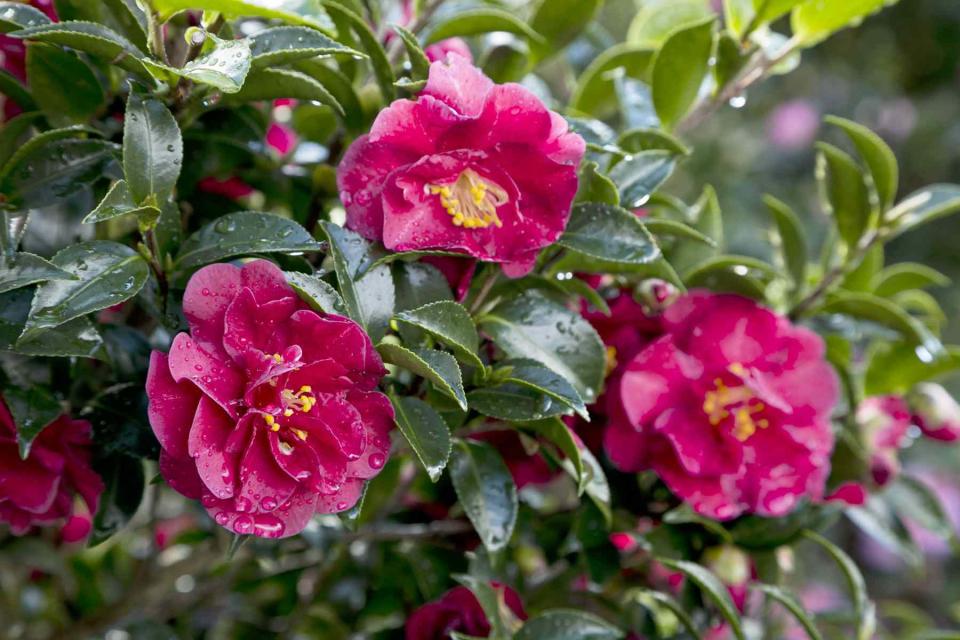
Southern Living Plant Collection
Sometimes you want to escape into the shelter and seclusion of your backyard, but with home lots shrinking, our yards are less private than they once were. That’s why planting for privacy has become more important than ever before. When it comes to creating private spaces, these 12 privacy shrubs provide several benefits over hardscape solutions like fences or lattice work. Shrubs contribute to a more aesthetic and relaxing atmosphere, adding colorful foliage, flowers, and fragrance to outdoor rooms. They help absorb noise from traffic or neighbors, providing a sense of serenity, and many shrubs also provide shelter for birds and other wildlife.
Tips for Selecting Privacy Shrubs
There are several factors to consider when selecting privacy shrubs. Evergreen shrubs provide year-round privacy, while deciduous shrubs commonly offer interesting ornamental traits such as flowers, fall foliage, or berries. Deciduous shrubs also allow more light to reach the landscape during winter. Try matching the mature height of your plantings to your privacy needs. For example, a taller selection is needed if you are trying to block the view into your yard from a neighboring balcony than if you are simply trying to create a sense of separation. It's also helpful to note how fast different species reach the desired height, as some shrubs are fast-growing and others quite slow. Finally, consider the amount of time you intend to spend on plant maintenance. This may help you decide between species best suited to formal shaping and trimming versus those more suitable to natural growth patterns.
Related: 13 Best Fast-Growing Trees To Create Privacy Without A Fence
Hick’s Yew
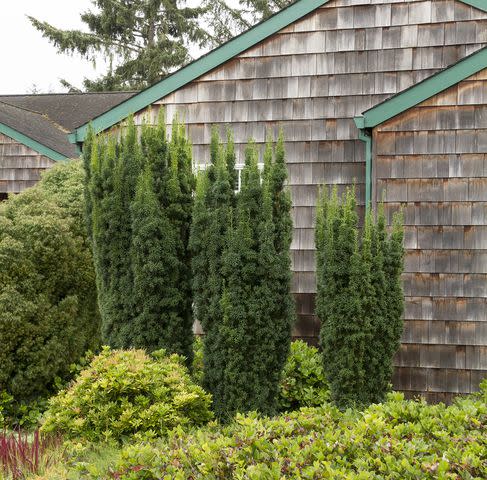
Monrovia.com by Doreen Wynja
Botanical Name: Taxus × media 'Hicksii'
Sun Exposure: Full Sun to Part Shade
Soil Type: Medium Moisture, Well-draining, Average Fertility
Soil pH: Mildly Acidic to Neutral (6.0-7.0)
If you love things looking clean and tidy, Hick’s yew is the shrub for you. This plant is perfect for shearing and shaping into formal hedges. When left to grow naturally, they take on a narrow columnar form. Tightly packed deep green foliage covers the upright branches, providing a dense screen. Hick’s yews can grow 18 to 20 feet tall and 6-10' wide after 20 years but are more commonly maintained around 10 feet tall and 3 to 4 feet wide.
Bright 'N Tight™ Carolina Laurel
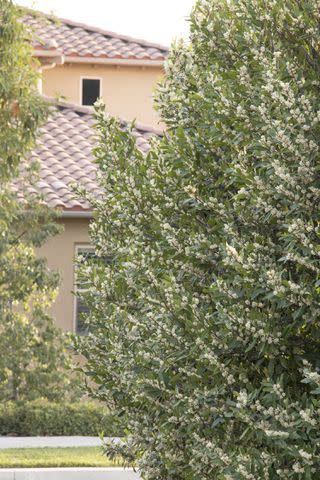
Monrovia.com by Doreen Wynja
Botanical Name: Prunus caroliniana 'Monus'
Sun Exposure: Full Sun to Part Shade
Soil Type: Moist, Well-draining, Rich
Soil pH: Slightly Acidic to Slightly Alkaline (5.5-8.0)
With fragrant spring blooms, shiny autumn berries, and handsome evergreen foliage, provides privacy and beauty all year round. This native shrub is a great choice for gardeners wishing to share their backyard oasis with birds and butterflies. Robins and cedar waxwings are common visitors in winter and early spring. Bright 'N Tight™ is a compact selection of Carolina laurel,
growing 8 to 10 feet tall and 6 to 8 feet wide in ten years.
Christmas Jewel® Holly
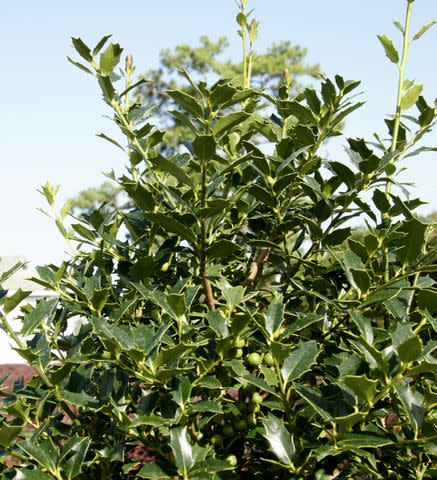
Southern Living Plant Collection
Botanical Name: Ilex hybrid 'HL 10-90'
Sun Exposure: Full Sun to Part Shade
Soil Type: Moist, Well-draining, Rich
Soil pH: Acidic (5.5-6.5)
Hollies make fabulous privacy shrubs, and few are as picture perfect as Christmas Jewel® Holly. This compact, upright holly maintains a pyramidal form without the need for pruning. Plants are self-fruitful (they don’t need a different pollinator) and produce a heavy load of bright red berries that shine through the winter months, providing late-winter food for songbirds. Christmas Jewel® grows 8 to 10 feet tall and 6 to 8 feet wide, making it quite adaptable to smaller landscapes.
Jolene Jolene® Beautybush
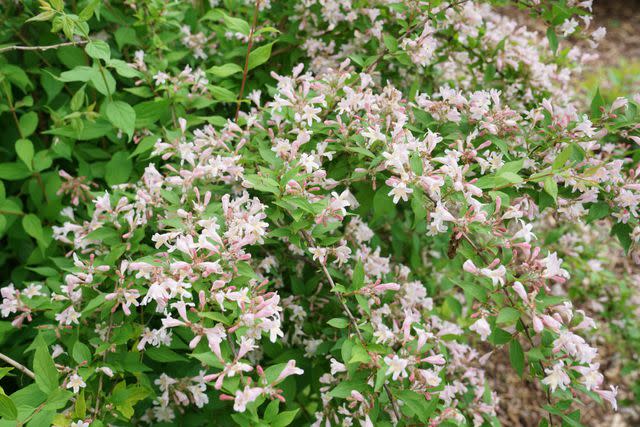
Proven Winners® ColorChoice®
Botanical Name: Linnaea (formerly Kolkwitzia) amabilis 'SMNKADTF'
Sun Exposure: Full Sun to Part Shade
Soil Type: Medium, Well-draining, Average Fertility
Soil pH: Neutral to Slightly Alkaline (6.0-8.0)
Jolene Jolene® Beautybush is a stunning specimen, with grand, arching branches covered in showy flowers that last for several weeks each spring. Pink, star-shaped blooms bear a yellow throat and attract bees and butterflies to the garden. This adaptable, low-maintenance deciduous shrub is half the size of old varieties, maturing to just 6 feet tall and wide.
October Magic® Camellias
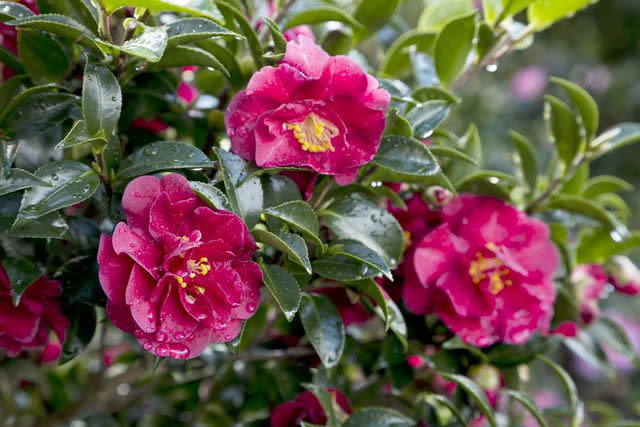
Southern Living Plant Collection
Botanical Name: Camellia sasanqua cultivars
Sun Exposure: Full Sun to Part Shade
Soil Type: Moist, Well-draining, Rich
Soil pH: Acidic to Neutral (5.8-6.5)
With dark and glossy evergreen foliage, Camellias provide year-round screening and privacy. They are also gorgeous plants, boasting rose-like blooms in vibrant red, pink, or white tones that invigorate the autumn garden. The diverse selection of October Magic® camellias includes compact varieties reaching only 3 to 4 feet in height to those topping out at 12 to 15 feet. Excellent drainage is essential to successfully growing camellias.
'Burgundy Spice' Sweetshrub
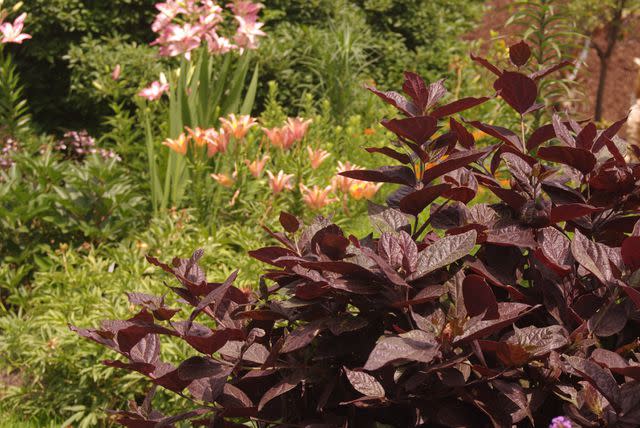
Pleasant Run Nursery
Botanical Name: Calycanthus floridus var. purpureus 'Burgundy Spice'
Sun Exposure: Dappled Sunlight to Part Shade
Soil Type: Medium Moisture, Well-draining, Average fertility
Soil pH: Acidic to Neutral (5.5-7.0)
This exciting new cultivar of the Southeast native sweetshrub provides an alternative to exotic loropetalum and finicky ninebark, with rich purplish-red foliage that holds its color through hot Southern summers. Fragrant spring blooms and yellow-orange fall foliage add seasonal interest. This woodland native is best suited to shadier areas of the landscape, with morning sun and filtered afternoon shade ideal.
'Blue Point' Juniper
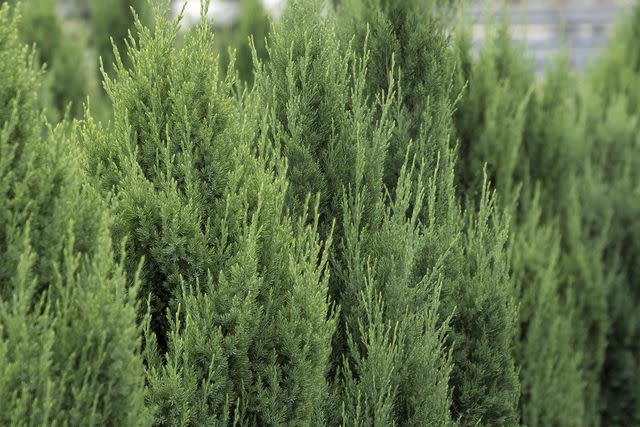
Monrovia.com by Doreen Wynja
Botanical Name: Juniperus chinensis 'Blue Point'
Sun Exposure: Full Sun
Soil Type: Medium, Well-draining, Average Fertility
Soil pH: Acidic to Alkaline (5.0-8.0)
With a broad, pyramidal form and dense blue-green foliage, this stately needled evergreen makes an adaptable privacy screen for difficult areas. Plants adapt readily to a variety of planting challenges including heat, drought, air pollution, and dry soils. 'Blue Point' maintains a lovely natural form with no pruning but also tolerates heavy clipping to create topiaries.
Oakleaf Hydrangea
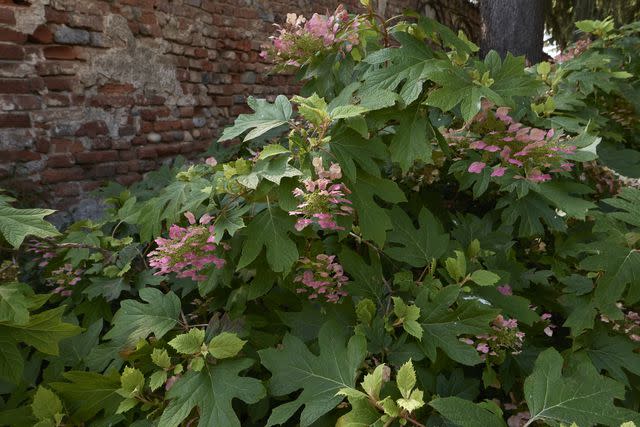
Getty Images /seven75
Botanical Name: Hydrangea quercifolia
Sun Exposure: Full Sun to Part Shade
Soil Type: Medium, Well-draining, Rich
Soil pH: Acidic to Alkaline (5.0 to 8.0)
Oakleaf hydrangeas make a dramatic privacy planting with deeply lobed foliage and huge, long-lasting blooms. Perfect for cutting and drying, the showy flower heads consist of white flowers packed onto pyramidal panicles. As summer lingers into autumn, the flower heads take on pink tones as the foliage turns a brilliant wine-red. Larger varieties such as 'Harmony', 'Snowflake', and 'Snow Queen' grow six feet tall and wide.
Arrowwood Viburnum
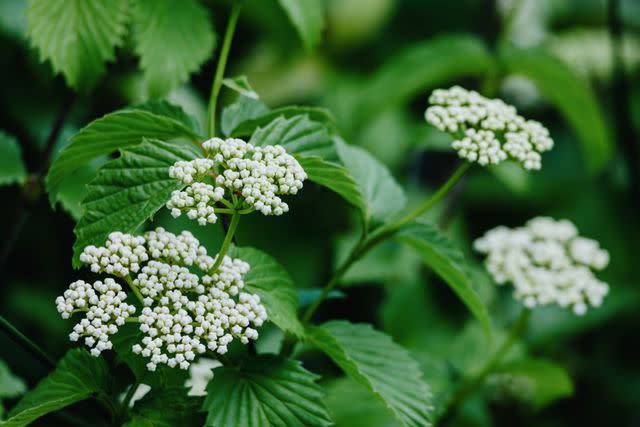
Getty Images / Grace Cary
Botanical Name: Viburnum dentatum
Sun Exposure: Full Sun to Part Shade
Soil Type: Medium, Well-draining, Average Fertility
Soil pH: Acidic to Neutral (5.0 to 7.5)
This native deciduous shrub is an excellent choice for nature-lovers. Large white flower clusters cover plants in spring attracting native bees. Blue-black fruits invite songbirds to feast from late summer though autumn, when the foliage turns shades of yellow, orange, and red. Plants produce long, straight stems and shiny, deeply-veined foliage.
Southern Wax Myrtle
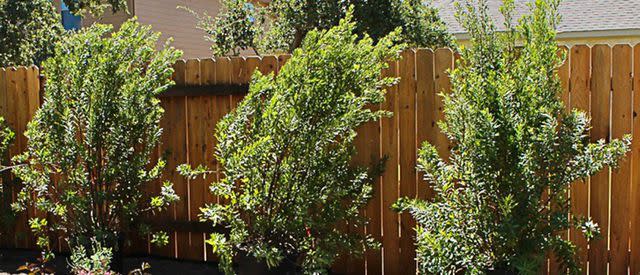
Diana Kirby
Botanical Name: Myrica cerifera
Sun Exposure: Full Sun to Part Shade
Soil Type: Medium to Moist, Well-draining, Average Fertility
Soil pH: Acidic (5.5-6.5)
This sprawling broadleaf evergreen grows too large for many landscapes but makes an excellent screen or privacy hedge where space allows. Native to the southeast, Southern wax myrtle tolerates salt, wind, and wet soils providing an excellent option for coastal gardens. Plants are also unbothered by confinement within pavement and other urban challenges. The small flowers are visited by native bees and butterflies, while songbirds feast on the berries. Yellow-rumped warblers and tree swallows are particularly attracted to the gray fruits.
Jade Waves® Fernspray False Cypress
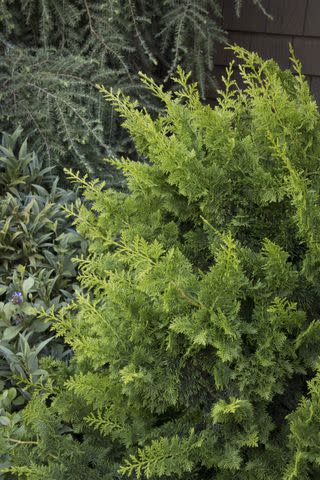
Monrovia.com by Doreen Wynja
Botanical Name: Chamaecyparis obtusa 'MonYur'
Sun Exposure: Full Sun
Soil Type: Moist, Well-draining, Rich
Soil pH: Acidic to Neutral (5.0-7.0)
This elegant, compact false cypress selection brings loads of texture to the landscape with flat sprays of fern-like foliage. Jade Waves® holds a pyramidal form without the need for pruning, providing formal structure without the work. Dark green foliage lightens toward the tips on dense branches. False cypress is slow-growing, but worth the wait.
'Florida Sunshine' Anise Shrub
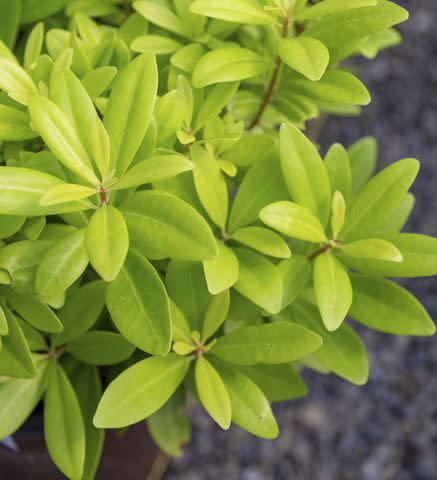
Southern Living Plant Collection
Botanical Name: Illicium parviflorum 'Florida Sunshine'
Sun Exposure: Partial Shade
Soil Type: Moist, Well-draining, Rich
Soil pH: Acidic (5.0-6.5)
A cultivated variety of the southeastern native anise shrub, 'Florida Sunshine' illuminates the landscape with chartreuse foliage that turns a brilliant gold in autumn. Winter brings a red tinge to the stems for added interest. This dense evergreen shrub is more compact than the species, growing 5 feet tall and up to 3 feet wide. Plants are resistant to deer browsing.
For more Southern Living news, make sure to sign up for our newsletter!
Read the original article on Southern Living.

